Many hard-gainers and people who struggle putting on mass use a mass gainer to help build muscle.
There are a lot of reasons you might want to put on mass—extra muscle is useful for athletic performance, overall strength and power.
The core ingredients are always high-energy density foods, like starches and proteins, but different mass gaining supplements target different processes of the muscle gaining process.
Some provide the protein and amino acids that are the building blocks of muscle, while others try to more directly stimulate your body’s muscular growth pathways, signaling it to increase muscle fiber synthesis. We’ve gone through the best mass gainers on the market and ranked them according to their effectiveness.
Research
Rankings
1. Transparent Labs Mass Gainer
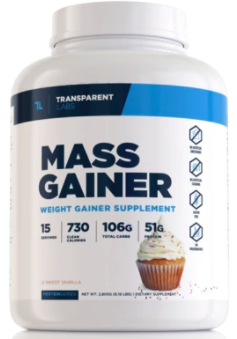
Click here for the lowest price
Transparent Labs Mass Gainer is the ultimate macronutrient source for the fastest burning hard-gainer.
Not only does Transparent Lab’s Mass Gainer contain a huge 740 calories per serving, but their macros are from clean sources so that you don’t miss out on any micronutrients.
Here are the hard specs: 109 grams clean carbs, 53 grams grass-fed whey protein, 12 grams of healthy fats, and 3 grams of creatine monohydrate per serving.
But how does it taste?
Short answer, fantastic.
By using quality natural ingredients, Transparent Labs Mass Gainer delivers a delicious and smooth taste that you’ll look forward to taking. That is something you can’t guarantee with other brands cut-rate, over-processed blends.
That’s why Transparent Labs’ Mass Gainer is our number 1 choice for 2021.
2. Optimum Nutrition Serious Mass
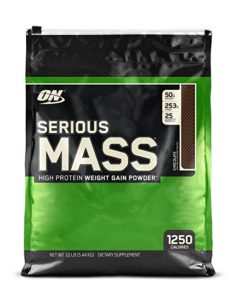
The incredibly popular Optimum Nutrition Serious Mass does a fantastic job of not neglecting micronutrients. Too often, mass gainers get caught up in “macro,” trying to ensure the carb, fat, and protein ratios are right, but forget that your body needs vitamins and minerals too.
Not this one. Optimum Nutrition practically puts a multivitamin into every serving of Serious Mass; your daily requirements for most vitamins and minerals are met or exceeded in one 1250 calorie serving.
The sugar content, 20 grams per serving, is somewhat high, but at least there are 4 grams of dietary fiber to slow the sugar-rush a bit. The protein comes from a blend of whey, egg, and milk protein, which is nice for variety, but it does rule out more people who have dietary restrictions.
3. MHP Up Your Mass
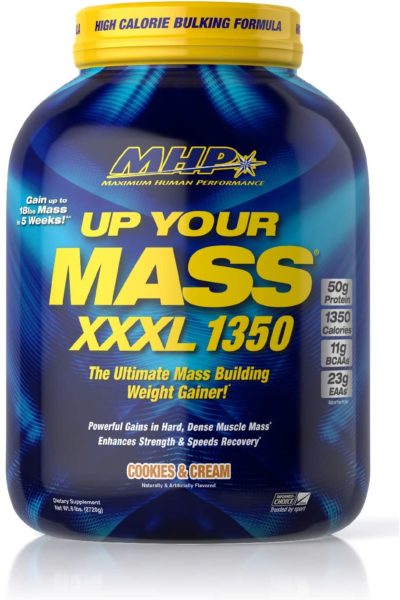
If you want to shift your macronutrient intake strongly towards protein, MHP’s Up Your Mass does it best. Even though each serving only has about 800 calories, each one has 62 grams of protein.
You’d need almost twice as high of a caloric content of most other mass gainers to get as much protein. In addition, it’s also got lots in the way of vitamins and minerals.
Extras like medium-chain triglycerides and omega-3 fatty acids sweeten the deal. On the subject of sweets, though, the sugar content of Up Your Mass is very high considering its lower caloric content, so it’s a better choice for people adding moderate amounts of calories to their diet.
4. BSN True-Mass

BSN’s True-Mass is another mass gainer that focuses on a greater caloric content coming from protein. At 46 grams per 700 calorie serving, it shifts the caloric balance more strongly away from carbohydrates.
The sugar content is fairly low, and there are a few extras, like medium chain triglyceride powder, but on the whole, this mass gainer does not really distinguish itself in any particular way.
5. Naked Mass

If you want to go hyper-minimal with your mass gainer, Naked Mass is the way to go. The ingredients list is astonishingly short.
There are only three things in this mass gainer: maltodextrin, whey protein concentrate, and casein. Do keep in mind that you will be lacking the micronutrients that you need (i.e. vitamins and minerals), but you can get them from the rest of your diet.
Another major advantage of Naked Mass is that its sugar content is very low (only five grams per 1250 calorie serving), meaning you can consume a lot of it without worrying about the negative metabolic effects of high sugar consumption.
6. Mass Tech Extreme 2000
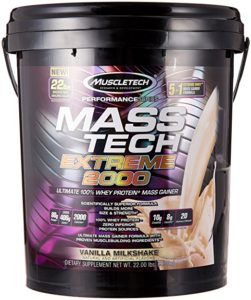
Mass Tech Extreme 2000 lives up to its name–at the recommended serving size, it delivers nearly 2000 calories by itself, and hits the mark if you add it to a glass of milk.
For a mass gainer with this many calories, its sugar content is very low. Seventeen grams in almost 1900 calories isn’t going to do much harm The protein is also all from whey, which is widely regarded as the highest-quality protein source.
7. MusclePharm Combat XL
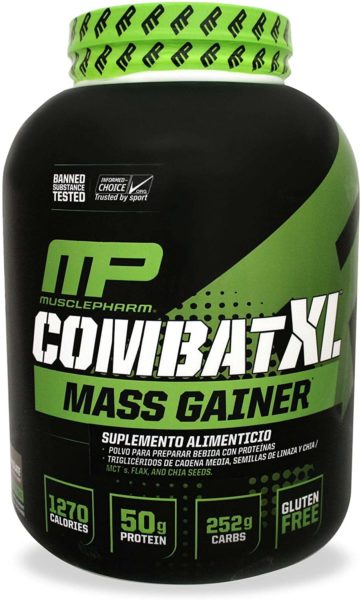
Combat XL from MusclePharm goes pretty heavy on the carbs, with over two-thirds of its weight coming straight from carbohydrates. At 50 grams per serving, the protein content is very solid.
The sugar content (17 grams per serving) isn’t outrageous, but it would be nice if this sugar was offset by a little fiber or more vitamins and minerals. As it stands, the blend is pretty weak on these extras.
8. Dymatize Super Mass Gainer

Dymatize Super Mass Gainer keeps the macro and micro nutrient content high in their mass gaining supplement.
The protein blend could be a little higher-quality–currently it’s a bend of whey protein concentrate, milk protein isolate,and whey protein isolate, and the sugar content is pretty high at 24 grams. It doesn’t have too many other perks or advantages, so it lends itself very much in the middle of the pack.
9. MuscleMeds Carnivor Mass
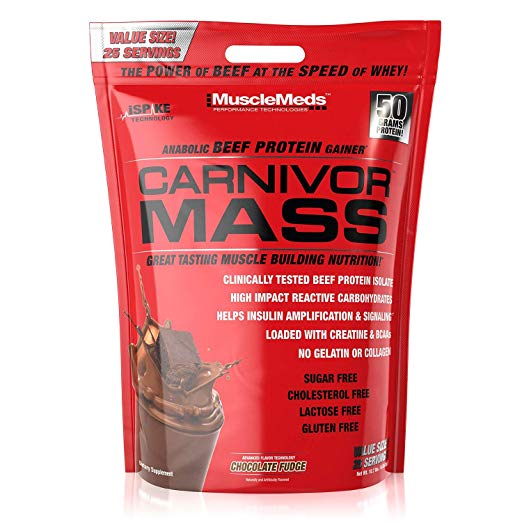
MuscleMeds Carnivor Mass has a unique pitch: instead of the usual dairy-derived protein, it uses hydrolyzed beef protein, plus creatine and BCAAs to power up your muscles.
The carbohydrates included are specifically engineered to be rapidly absorbed, which will get you an insulin spike for building muscle, but could also precipitate metabolic dysfunction if used for too long. It’s a little high in artificial flavors and a little low in vitamins and minerals to end up any higher in the rankings.
10. Labrada Muscle Mass Gainer
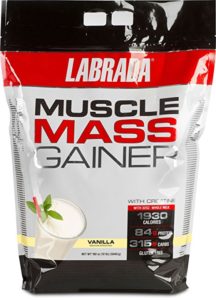
Bodybuilding champion Lee Labrada’s mass gainer is surprising in that its ingredients aren’t particularly innovative or groundbreaking.
In fact, they seem like pretty much any boilerplate mass gainer: maltodextrin, 50 grams of protein, and a moderate amount of sugar. There isn’t much in the way of extra bonuses, like vitamins, minerals, or supplements that help with mass gain, either.
Category winners
Best mass gainer overall: Transparent Labs Mass Gainer
Transparent Labs Mass Gainer is a clean source of all three major macronutrients, derived from great sources like whey protein and coconut milk powder. On top of that, it uses strictly natural flavoring agents, like cocoa and monk fruit, for taste. Thanks to this clean supplement design, it’s our all-around favorite.
Best mass gainer for bodybuilders: Optimum Nutrition Serious Mass
For adding mass as quickly as possible, Optimum Nutrition fits the bill thanks to its inclusion of a wide range of vitamins and minerals. This means it provides your body with all of the building blocks it needs to synthesize muscle during a bulking phase.
Best mass gainer for athletes: Transparent Labs Mass Gainer
With a great balance of protein and carb, plus creatine for increased muscle power, Transparent Labs is the clear choice for athletes. Its minimalist design also helps prevent some of the digestion problems that can be spurred by other mass gainers bloated with sugar and artificial ingredients.
Best mass gainer for people with a sensitive stomach: Naked Mass
Are bloated mass gainers causing you gastrointestinal problems? Opt for Naked Mass, which is as simple and clean as a mass gainer can get. With just three ingredients (maltodextrin, whey protein, and casein) it’s the easiest on your stomach if you don’t mind the mild unflavored taste.
Best mass gainer for women: BSN True-Mass
Women looking to bulk up should opt for more protein and fewer carbs, because they don’t have the testosterone levels to keep fat oxidation high during a bulking phase. BSN True-Mass does a great job of delivering calories without a carbohydrate overload, making it our recommended pick for women.
Best mass gainer with creatine: Transparent Labs Mass Gainer
Creatine is one of the most-proven supplements out there for increasing muscle size and mass, so it makes sense to combine it with your mass gainer. Transparent Labs Mass Gainer does the best job of any mass gainer on the market, supplying three grams of creatine per serving.
Who should buy a mass gainer?
Mass gainers are made for a very specific population: athletes who compete in sports where a higher body mass confers a huge advantage. This includes sports like football, rugby, and combat sports, to name just a few.
Since increasing your body mass is fundamentally a function of increasing your calorie intake relative to your caloric expenditure, it can be very tough to add body mass rapidly when you are also doing an intense training routine that burns a lot of calories. Mass gainers are designed explicitly to address this problem.
By providing a huge amount of calories, mass gainer powder can be easily mixed into water to effectively add hundreds or thousands of calories per day into your diet. High quality mass gainers often supplement the calories with additional vitamins and minerals so you aren’t facing any deficiencies.
Unlike the broader category of protein supplements, mass gainers face a much narrower niche of people for whom they are a good idea. Recreational athletes and people looking to gain muscle but not body fat should not use a mass gainer: they’d be better off with a pure source of protein.
Even though you’ll gain body mass more slowly, you’ll put on relatively less body fat as a function of muscle mass gain. Mass gainers also are not a good idea if you are skinny and looking to gain weight, but don’t actually exercise much.
Without a high energy expenditure (which athletes achieve in their intense workouts), all of the carbohydrates in a mass gainer are going to get deposited as fat, so while you will “bulk up,” it will mostly be body fat, not muscle.
Without exercise, the carbs in a mass gainer will also hit your liver pretty hard, which could raise your risk of metabolic disease.
How we ranked
Our rankings of the top mass gainers on the market were first and foremost predicated on the caloric content: since you won’t be gaining any mass if the caloric content is not high enough, we focused only on high-calorie mass gainers that included enough protein for muscle gain and enough carbs to pack on body mass.
Broadly, we sorted products into two camps based on the design philosophy of the mass gainer.
One camp consisted of mass gainers that were designed like meal replacement shakes, with a lot of flavor, a pleasant texture and taste, and vitamins and minerals that can partially make up for the nutrients you’d get from an actual full-sized meal.
The other camp consistent of the more minimalist approach to mass gainers. These products contain protein, carbs, a bit of flavoring, and not much else.
Both of these strategies of supplement design have merits, so we evaluated these categories independently and selected the top performers from each. Within the “complete” mass gainers, we looked for products that tasted great and had high-quality micronutrients alongside their protein and carbohydrate content.
Within the “minimalist” mass gainers, we put a high priority on purity of ingredients, natural sources for flavors and sweeteners (like using stevia instead of artificial sweeteners), and high-quality sources of protein and carbohydrate.
Whether you are looking for a mass gainer more in the style of a meal replacement shake or a mass gainer in a more pure and minimalist style, you can find what you’re looking for in our rankings.
Benefits
If you want to put on weight (and ideally, muscle too), your normal food intake can become a limiting factor pretty quickly. In natural foods, the caloric content is locked up in plant cells and fiber, so it takes a lot of chewing and digesting to extract the calories.
This is great for people who are trying to lose weight; this is why one of the best things you can do to lose weight is eat natural and raw foods. But if you are trying to gain weight, often you’ll need a mass gainer to give your system the calories it needs to increase your mass as quickly as possible.
Calorie content is the most important characteristic of a mass gainer. There are several things you should look for in a mass gainer that optimize your weight gain with the minimum number of side effects.
Number one is the most simple: the straight-up caloric content. The facts are pretty simple: if you want to gain weight, you have to take in more energy than you expend.
So, if you want to full benefits of hitting your mass gain goals, you need to make sure the caloric content of your mass gainer is high.
Most high quality mass gainers accomplish this by delivering a mixture of maltodextrin (a simple but not overly sweet carbohydrate), protein, and often, fat.
A mass gainer with a relatively high fat content is especially attractive because of the caloric content of fat. It’s got twice as many calories per gram than carbohydrates or protein, so it’s an incredibly efficient energy source for adding mass.
The other two major macronutrients are, of course, carbohydrates and protein. According to recommendations by researchers at McMaster University in Canada, people attempting to gain body mass and maximize muscle mass gains at the same time should aim for approximately 1.7 grams of protein intake per kilogram of (current) body mass (1).
Of course, as your mass gaining program takes effect, your body mass will increase, as will your protein needs. So plan ahead.
The source of protein in your mass gainer could have some effect on the rate at which you gain mass. Protein derived from whey is metabolized faster, and may be slightly more effective at adding muscle mass, compared to soy protein (2).
Soy protein does have a slight edge when it comes to antioxidant protection, but given that mass gaining programs are usually measured in months, not years, the oxidative damage issue is less of a concern (3).
The best possible combination might be whey protein and casein protein, another milk derived protein. This is because whey protein is metabolized quickly, while casein protein is metabolized slowly. These together in combination should keep a steady supply of protein available to your body for mass gain (4).
Speed of metabolic absorption also affects the carbohydrates of choice in a mass gainer. Ideally, you want carbohydrates with a low glycemic index.
This is a measure of how quickly the carbohydrates are absorbed into your body and turned into sugar in your bloodstream. A rush of sugar after a big meal is not healthy; over time it can cause metabolic syndrome and eventually even type two diabetes.
Maltodextrin, the main source of carbs in many mass gainers, has a fairly high glycemic index. To make things even more difficult, other simple carbohydrates, like fructose, have a low glycemic index, but only because the sugar is going straight to your liver instead of your blood.
This leaves you in a tricky spot: you can’t gain mass without a heft carbohydrate intake, but you should still do your best to keep the sugar content and the high glycemic index carbohydrates under control.
One of the ways to do this is via the fiber content: fiber slows down the absorption of carbohydrates in your stomach (5).
This, too, has its drawbacks with mass gainers: too much fiber fills you up, and makes it difficult to eat more. That’s why fiber is such a great supplement for weight loss–it helps your body tamp down on its hunger.
Mass gainers aren’t the optimal strategy for maintaining a strong and healthy body in the long-term. Mass gainers have a very specific and narrow application: they are for athletes in weight-dominated sports like football and combat sports who are trying to gain as much body mass as fast as possible, and who aren’t particularly worried about adding some excess body fat in the process.
Of course, the goal is to put on muscle primarily, but if you want maximal body mass gains as quickly as possible, you’re going to have to accept adding some body fat as well. Even bodybuilders know this; that’s why they alternate between bulking up and cutting body fat.
Many people confuse mass gainers with more general protein powder supplements that are specifically geared towards gaining muscle, while keeping body fat gains to a minimum.
Protein is actually a great supplement for weight loss thanks to the fact that digesting and processing the amino acids in protein requires more energy than processing fat or carbohydrates, and because of the fact that protein acts as an appetite suppressant, which makes you less inclined to eat more at your next meal.
These reasons are why, paradoxically, protein powder can help you both drop body fat and gain muscle mass. For most people who want to slowly increase their muscle mass and decrease their fat mass, a protein powder like whey protein or pea protein is a better option.
The rapid body mass gain induced by a mass gainer is not the best solution for long-term health because of the propensity for all of the processed carbohydrates in a mass gainer to negatively affect your blood sugar metabolism, which could eventually lead to metabolic syndrome and type two diabetes.
Of course, this isn’t usually a problem for athletes, since they only use mass gainers for a few weeks or months at a time, and are workout out very intensely at the same.
For short-term, extremely rapid body mass gains, use a mass gainer; for long-term increases in muscle mass without the added body fat, use a protein powder.
Side Effects
Since mass gainers are really just very efficient macronutrient sources, the only side effects are related to the macronutrients they provide.
The first risk, alluded to earlier, is the metabolic effects of very high carbohydrate intake, especially when it’s high glycemic index carbs.
As reported in the scientific journal Diabetes Care, high intakes of high glycemic index foods over long periods of time is associated with the development of insulin resistance, the classic precursor to metabolic syndrome and type two diabetes (6).
Assuming your mass gain program is not too long, however, this shouldn’t be a major concern. If you are worried about this, choose a mass gainer that is high in fiber and low in carbohydrates.
The other issue you may encounter with mass gainers is constipation, and it’s also related to the high caloric intake relative to the fiber content.
Research consistently demonstrates that low fiber intake is a risk factor for chronic constipation, and mass gainers are perhaps the epitome of a high calorie, low fiber food (7).
To fix this, try taking a fiber supplement at night, right before going to bed. This way, it won’t interfere with your caloric intake goals.
Recommended Dosage
Most online calculators for gaining muscle recommend modest increases in caloric intake, but the scientific literature tells a different story.
To get maximum results, don’t be afraid of a massive increase in caloric intake. One study, published in 2002 in the Journal of Sports Medicine and Physical Fitness, demonstrated that a 2100 Calorie intake increase from a mass gaining supplement resulted in a consistent gain of one pound per week more than a control group on a similar exercise program that did not receive a mass gaining supplement (8).
FAQ
Q: What is a mass gainer?
A: A mass gainer is a powdered supplement that you can mix with water. The primary macronutrient ingredients in a mass gainer are simple, rapidly absorbed carbohydrates along with a quality source of protein (often derived from whey, casein, or egg white protein).
Mass gainers are essentially a supercharged meal replacement shake, except instead of being designed to help you lose weight, they are (as the name suggests) explicitly designed to add body mass as quickly as possible.
Don’t confuse mass gainers with run of the mill protein powders: a protein powder will not add body mass nearly as fast as a mass gainer, but has the benefit of not adding body fat to nearly the degree that a mass gainer will.
Q: Is it good to take a mass gainer?
A: Whether it’s “good” to take a mass gainer depends on what your exact performance and health goals are. Unlike a protein powder, which has pretty broad applications that are flexible for a wide variety of health goals, a mass gainer is a very narrow and focused tool.
If your operational definition of “good” hinges on adding bulk as quickly as possible, so you can perform in a weight-dominant sport, a mass gainer is exactly what you need. If, in contrast, your goals are to maintain a good physique and add muscular strength, other sources of protein are a better bet. Of course, it goes without saying that mass gainers are antithetical to your aims if you want to lose weight.
Q: What does a mass gainer do to your body?
A: A mass gainer is really just a hyper-efficient way to provide calories to your body so you can increase your overall body mass.
The calorie distribution in a mass gainer is about the appropriate amount to replenish both muscle protein and muscle glycogen after an extremely tough workout; there is a substantial amount of protein powder included as part of a mass gainer, but the remainder (in fact, the majority) of the calories come from simple carbohydrates–usually maltodextrin.
While bulking up with a mass gainer is one of the most efficient ways to add body mass, mass gainers have faced well-justified criticism that gaining body mass in this way is not optimal for long-term health.
The high glycemic index of maltodextrin and similar sources of carbohydrates that you’ll find in mass gainers can lead to insulin resistance, and definitely adds more body fat than you’d get with protein alone.
Q: What is the difference between a mass gainer and weight gainer?
A: Mass gainers and weight gainers are the same thing. As long as it’s a powdered supplement that contains carbohydrates and protein powder as its main constituents, it’s a mass gainer regardless of what the manufacturer calls it.
A supplement with this formulation is designed for maximal body mass gain in a minimum amount of time, which is why these products are very popular among athletes who compete in sports where bigger body mass confers a competitive advantage.
Q: When should you take a mass gainer?
A: Since mass gainers are so calorie-dense and high in their glycemic index, you generally want to space them out throughout the day. There’s one exception, though, which is after you work out.
Soon after a workout (within about 30 minutes of finishing), you should take a hefty dose of mass gainer to ramp up your recovery and maximize your muscle gain.
Consuming a mass gainer right after working out is also preferable from a blood sugar and fat gain perspective; since your muscles are starved for glucose after finishing a workout, taking a mass gainer will replenish these muscular glycogen stores and limit the amount of glucose that ends up in your fat cells.
Q: What is in mass gainer?
A: The basic constituents of a mass gainer are pretty straightforward: a strong amount of protein (either whey or casein protein, typically), plus a source of carbohydrates. Most often, these carbs come in the form of maltodextrin, which is a rapidly-absorbed processed carbohydrate.
Most mass gainers also add in some flavoring, plus vitamins and minerals as well. Maltodextrin has a fairly high glycemic index, which means that the glucose that it contains it is absorbed into your bloodstream quite rapidly.
If you are doing long, punishing workouts, this means you can replenish your muscular glycogen stores rapidly as well, but it also contributes to bulking up in the form of body fat.
When you have a lot of excess glucose in your system, and your muscular glycogen stores are topped off, the excess glucose gets pulled into your fat cells. This basic biological mechanism underscores why mass gainers are great for athletes who want rapid body mass gain, but a poor choice for general fitness enthusiasts who want more muscle, but not at the expense of more body fat.
Q: How do you not get fat from a mass gainer?
A: Putting on excess body fat from a mass gainer could be a function of taking too much mass gainer relative to the amount of exercise that you get, or not working out intensely enough while on a mass gainer.
Remember, the recommended doses are formulated with serious athletes in mind. You might also just be unlucky: some people’s metabolism has a tendency to take the carbs in a mass gainer and shuttle them straight to fat cells, virtually without fail. If this is the case, you might benefit from a low-carb diet and a keto shake instead of a mass gainer.
Q: How many scoops of mass gainer should you use?
A: Most of the scientific research indicates that maximal mass gains require pretty aggressive caloric supplementation—on the order of 2100 additional calories per day in the form of a mass gainer.
In a typical mass gainer, you’ll get between 500 and 625 calories per scoop, so if you wanted to shoot for 2000+ additional calories per day, you would want a total of four scoops. Of course, you don’t want to take that all at once: split it up into two, three, or even four separate doses throughout the day for maximal effect.
Splitting up your dose will help prevent bloating and other side effects, will lower the glycemic load your body has to face all in one sitting, and will help keep your caloric intake and energy levels steady throughout the day.
Related articles
- Protein for weight loss
- Whey protein powder
- Post-workout supplements
- Natural steroid alternatives
- HGH supplements
- Testosterone boosters
- HMB
- Bulking stack
Recap
Gaining mass is all about calories in and calories out. Specifically, you want a lot more coming in than going out.
The best way to do this is with a mass gainer that has a fairly high protein content, including a mix between whey and casein protein.
Do your best to keep the sugar content under control, and don’t be afraid of high doses of a mass gainer if your goal is to put on pounds as quickly as possible.
For BodyNutrition‘s #1 mass gainer recommendation, click here.